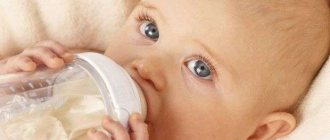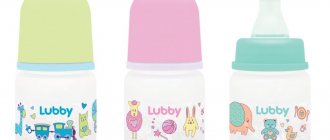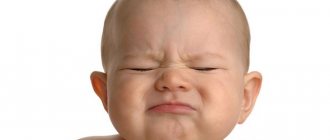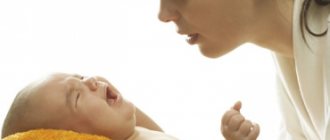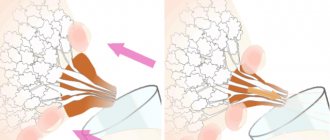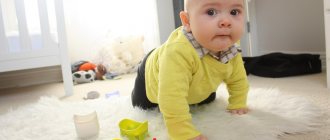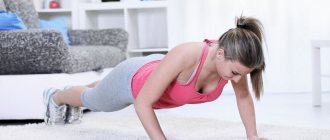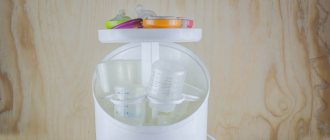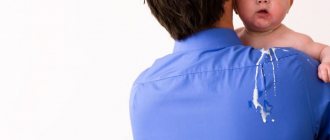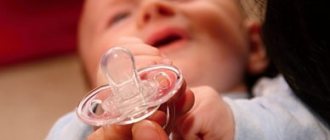All 7 ways to sterilize baby bottles and pacifiers for newborns
Formula-fed children are often exposed to infections of the digestive system and oral cavity.
This is due to non-compliance with basic hygiene rules and improper care of children's supplies. The baby’s immune system at this age is not yet fully formed and is susceptible to pathogens. To reduce the likelihood of developing diseases, you need to know how to sterilize bottles for newborns and what else should be processed.
Learning to sterilize baby bottles: preparation
Before the disinfection procedure, it is necessary to prepare the dishes. It should be washed well. Baby bottles need to be cleaned to the very bottom of milk residues with a brush and baking soda. The pacifier should be removed and processed separately.
You can also wash baby feeding utensils in the dishwasher. This procedure should be carried out separately from the belongings of other family members. For cleaning you should use softening detergents.
Sterilization methods
There are several main methods of sterilization , each of them requires compliance with certain rules. It is worth considering them separately and choosing the best one. This will protect the baby in the first months of life from germs, fungal spores, and viruses.
Sterilizing a bottle in boiling water
This classic method does not require special tools or devices. The procedure is carried out using a pan of water. The downside is that when the nipple is boiled, the material is often deformed.
Sequencing:
- Fill the pan 2/3 full with water.
- Dip all the devices into it until the liquid completely covers them.
- Place a plate or bowl on top to prevent items from floating.
- Heat water to boiling and boil for 10 minutes.
- Remove container from heat.
- Remove items from the water when they have cooled.
Be sure to read:
Storing bags in the kitchen with your own hands: 7 fashionable ways + photos, videos
The sterility of the dishes remains for about a day, then the procedure should be repeated.
Sterilization using a microwave
To simplify the disinfection process, use a microwave oven. You can safely sterilize household items in it.
Attention! It is strictly forbidden to place metal parts of dishes in the microwave, as this will lead to damage.
Procedure:
- Place utensils and pacifiers in a special bowl.
- Fill it with liquid so that the liquid fills all the voids.
- Close the container with a special lid.
- Put it in the microwave.
- Turn on the microwave at full power and disinfect for 8 minutes.
There is no need to rush to take out the devices; let them cool down first.
Many manufacturers of baby supplies produce special dishes that can be processed in the microwave without the use of liquid.
Simply place the bottles in the microwave and turn it on for 5-7 minutes. During the procedure, the material is not deformed.
Sterilization using a multicooker
A slow cooker is also suitable for disinfection. Wash the container thoroughly before use.
Main processing methods:
- Place items in the bowl vertically or horizontally (depending on the model). Fill with liquid to the maximum. Select temperature mode 100 °C. Treatment duration is 15-30 minutes.
- Pour water into the container to fill 1/2 of the entire volume. Place a grate on top intended for steaming food. Place the bottles on it and close the bowl with a lid. Turn on the steamer at 100°C. The duration of the procedure is 15-20 minutes.
Regardless of exposure to water or steam and the method chosen, bottle sterilization will be complete.
Modern models of multicookers are equipped with a disinfection function:
- water – for sterilizing bottles,
- steam – for processing nipples and nozzles.
Sterilizer
On sale you can find a special electric sterilizer that is designed to disinfect children's household items. The device fits 6 bottles and nipples.
Basic actions:
- Fill the device with liquid. The volume depends on the model. For standard sterilizers it is 200 ml.
- Place the bottles with the neck down, since the heating device is at the bottom and the steam rises up. Place nipples on top.
- Close the lid of the device tightly and check that there are no gaps so that the steam does not escape.
- Turn on the sterilizer for 5-10 minutes.
- After the procedure, you cannot immediately take out objects to avoid getting burned.
Be sure to read:
DIY storage box for children's toys made from scrap materials
If the sterilizer lid is not opened after disinfection, the bottles can remain in it for up to 6 hours.
Steam sterilization
Steam treatment is the simplest and most accessible method.
The procedure is carried out in several ways:
- Place the kettle on the stove. Boil the liquid and open the spout. Take the bottle with an oven mitt and turn it upside down. Bring it to the steam stream and leave for 15 minutes. Place the nipples separately in a cup and pour boiling water over them.
- Fill the pan 2/3 full with liquid and boil. Place a wire pan rack on top of the pan and place bottles and teats on it. Processing time – 20 min.
Do not forget! To avoid getting burns when disinfecting with steam, you should follow safety precautions.
Disinfection with antiseptic tablets
In this case, disinfection of children's equipment is carried out without the use of hot water. The method is suitable for parents leading an active lifestyle. For the procedure, you must purchase antiseptic tablets from the pharmacy in advance.
Algorithm for the procedure:
- Dissolve the tablet in cold water according to the attached instructions.
- Pour the solution into a deep container or bag.
- Immerse bottles and nipples in it so that the liquid completely covers them.
- Leave for 30 minutes.
The tablets contain sodium dichloroisocyanurate, which when combined with water forms a disinfecting solution that is safe for processing.
Despite the availability of the method, young mothers prefer to use it only on the road, when it is not possible to carry out steam treatment.
At what age should bottles be sterilized?
Children's accessories should be sterilized before the age of one and a half years. Afterwards, the child begins to actively explore life, including putting all sorts of objects into his mouth, and therefore encounters various microbes.
At this point, the immune system is already well formed and is able to withstand the attack of microorganisms. Mom just needs to thoroughly wash the dishes from any remaining milk and formula.
Be sure to read:
Storing bags in the kitchen with your own hands: 7 fashionable ways + photos, videos
What else needs sterilization?
It is necessary to sterilize all devices intended for contact with the oral cavity and feeding (nozzles for baby dishes, pacifiers, drinking cups, teething rings, etc.). This will protect the baby from exposure to bacteria.
Now many pediatricians dispute the need for sterilization over such a long period. In their opinion, this prevents the development of immunity to common infections.
But the hypothesis has not yet been confirmed, so parents decide on the issue of sterilizing dishes on their own.
The main thing is not to forget about the baby’s health.
Source: https://comp-plus.ru/hranenie/7-sposobov-kak-sterilizovat-butylochki-pustyshki-i-soski-dlya-kormleniya-v-domashnih-usloviyah
Why do you need to sterilize baby equipment?
A child’s body develops and improves over the course of one to two years, and therefore it is extremely susceptible to various diseases, including infectious ones.
If you do not follow the basic rules of sterilization, this can result in serious illnesses, food poisoning with severe symptoms (nausea, severe vomiting, bowel dysfunction, high fever, etc.). To restore the child’s health, he will have to be admitted to the hospital. Any mother is unlikely to want this, and therefore it is better to be safe. Every time after finishing feeding, the used bottle and pacifier should be washed and sterilized. A certain sequence of actions matters...
First of all, we thoroughly rinse the bottle and pacifier with warm water - you can do this in a splash of tap water. Next, we wash the bottle and pacifier in hot soapy water. You need to wash the bottle both outside and inside; We use a special brush - a brush. You can’t limit yourself to rinsing the bottle; It is absolutely unacceptable for even a small amount of milk formula to remain on the walls of the bottle. Having finished washing the bottle, we take up the nipple. It must be washed by hand - also outside and inside; To make it easier to wash the inner surface, the pacifier can be turned out. White milky deposits should not remain anywhere on the nipple, since this deposit is an excellent breeding ground for various pathogenic bacteria. The nipple holes also require cleaning. These holes are easy to clean if you strongly squeeze the tip of the nipple from the sides - the holes seem to turn out. A wooden toothpick will also help clean the holes in the nipple; however, the toothpick must be brand new, unused for its intended purpose. After cleaning each hole, we wash off the soapy water and remaining formula from the nipple. This completes the washing.
Now we are preparing for sterilization: we place a small towel (you can use a diaper) at the bottom of a pan of a suitable container: we place bottles and nipples on this towel; The bottles must lie on their sides, and the nipples - as necessary. Next, we pour cold water into the pan; the amount of water should be such that the bottles are covered with it; We also pay attention to filling bottles and nipples with water - there should be no air bubbles anywhere.
Cover with a lid and place the pan on the fire. As soon as the water in the pan boils, we can consider sterilization started. In total, sterilization (boiling) of bottles and nipples should last from 5 to 10 minutes - no less, no more.
After the boiling is completed, we pour the water out of the pan - and we do this with the lid closed. Also, without removing the lid from the pan, wait for the bottles and nipples to cool down; you should not force this process in any way - pour cold water over the pan or place it in the refrigerator for some time, cover it with ice, etc.; we just have to sterilize dishes and pacifiers in a timely manner so that the need for another bottle or pacifier does not push us. So, wait until the pan cools to room temperature. After this we can remove the contents of the pan. We carefully place all the bottles that we have sterilized on a towel with their necks down. We place the nipples on a sterile saucer and cover them with a sterile glass or a sterile jar. If we remove bottles from the pan by hand, then the nipples should be removed with sterile tweezers.
Every mother, especially those expecting her first child, should know how to sterilize baby bottles
The appearance of a baby in a family always puts the family in a special mode. A baby bottle becomes a common household item, and washing it becomes a routine procedure. Some mothers take this extremely seriously and strive not only to wash, but also to sterilize dishes after each feeding, zealously protecting their baby from germs.
Newborn babies often suffer from colic and stool disorders, the reason for this is the imperfection of the digestive system, which in the first months of life experiences increased stress and learns to digest incoming food. The ingress of pathogenic flora with dishes or a pacifier will create additional pressure on the body. What is the easiest baby bottle to keep clean at home?
How to properly sterilize a pacifier before first use, processing methods
In the first months of life, it is important that the child grows up clean. An indispensable attribute of a baby is a pacifier. During the day, the little fidget drops it a large number of times.
It is important to clean the pacifier after falling, as pathogenic bacteria rush to the “target” with lightning speed.
So whether it is necessary to process it over and over again, or simple rinsing is enough, and how to sterilize the pacifier before the first use, we will consider further.
Why treat a pacifier before first use?
At every step, the baby is lurked by bacteria that a weak immune system cannot cope with on its own. Therefore, the efforts of a young mother should be aimed at organizing everyday life for the comfortable development of her child. The answer to the question about sterilizing a pacifier is clear - it is worth sterilizing - both before the first use and subsequently.
Processing dishes before sterilization
It is important that the dishes in which the first and subsequent sterilizations will take place are processed. Conventional detergents used in everyday life are not suitable for children's dishes, as they have a chemical composition and, if not processed carefully enough, lead to allergic reactions and even dysbacteriosis.
Laundry soap and soda are safe for children's dishes. They are not capable of leading to allergic reactions, but do an excellent job of disinfection. To process dishes for further safe use, you must follow the following recommendations:
- all parts of the bottle must be individually and thoroughly washed;
- the pacifier is unusable if a white coating has formed inside the silicone cavity;
- if a baby bites through a favorite attribute, it can no longer be used;
- Both nipples and bottles should be sterilized;
- It is strictly prohibited to use “adult” chemicals to clean dishes.
If you follow these simple rules, sterilization of nipples and bottles will be successful.
How to sterilize baby pacifiers?
There are many ways to sterilize nipples. Let's consider the basic methods, proven over the years and by experienced mothers.
Boiling
Boiling is the most accessible and effective method of sterilization. In order to carry out boiling, you should take a pre-washed pan, pour water into it, and bring to a boil. Immerse the pacifier in it and boil for several minutes or put it in boiling water without boiling. Both methods will cope with the elimination of bacteria.
You can also clean the pacifier of germs using steam. To do this, just hold the pacifier over a pan of boiling water.
If there are several pacifiers, or you need to disinfect a feeding bottle, you can use a steamer pan. To do this, take a container, fill it with water, wait until it boils completely, place the bottles upside down in the steamer and hold them over the steam for 3-4 minutes.
In a steamer or dishwasher
Automated household appliances are excellent assistants in sterilizing pacifiers. An electric steamer has a number of advantages. It makes it possible to set the temperature and time mode, and also quickly copes with the task.
Can bottles and nipples be sterilized in the dishwasher? The answer is yes if the dishwasher is equipped with a setting greater than 80 degrees. At lower temperatures, sterilization will not occur, and the material will wear out from time to time.
Microwave
A microwave, like a dishwasher, is not designed to sterilize nipples, but it is still possible to clean it using it. To do this, you need to take a clean container in which the process will take place, immerse the pacifiers in water and clean at maximum power for 7-8 minutes.
Using a sterilizer
Of the household items listed above, the most suitable for cleaning bottles and pacifiers is a sterilizer. It is easy to use, affordable and perfectly destroys bacteria using an ultraviolet lamp.
We treat with antiseptics
An antiseptic is a drug that you can purchase at a pharmacy, used to disinfect household items, and has a chemical composition.
Application: dissolve the antiseptic tablet in a five-liter container of water, immerse pacifiers or bottles in water for 15 minutes, then rinse with boiled water. It would seem that the job is done, the microbes are killed, and this is so. However, after using the antiseptic, an unpleasant odor remains, due to which the baby may refuse the pacifier.
What to consider when sterilizing nipples
There is no consensus on how often the pacifier should be sterilized. Some are of the opinion that boiling is only necessary when purchasing an attribute or when the baby is ill, while other parents sterilize bottles and nipples several times every day.
It is important to follow the following rules:
- Keep disinfection utensils clean and boil before use.
- Boiling for a few minutes is the key to a clean pacifier. Bacteria do not live at high temperatures for more than a minute.
- All parts of the pacifier should be sterilized, not just the latex or silicone part.
- Rinsing with cold tap water is unacceptable and can lead to dysbacteriosis.
With the birth of a baby, many questions and doubts arise about how to properly care for him so as not to harm him. Sterilizing the pacifier is no exception. Each mother chooses one method or another. But it should be remembered that cleanliness is the key to the health and well-being of the child.
Source: https://grudnichky.ru/uxod/kak-sterilizovat-pustyishku.html
Is it always necessary to sterilize?
Young parents of first-born children, who do not have their own experience, are forced to choose between the advice of progressive pediatricians and the harsh pressure of pediatricians of the old Soviet school and grandmothers and aunties who raised their children in Soviet traditions.
According to this concept, the child cannot independently protect himself from infection and must be surrounded by maximum sterility. Therefore, bottles and all baby dishes need to be not just washed, but sterilized.
The Ukrainian pediatrician Komarovsky and a number of pediatricians of the new school have a completely different position - they believe that parents should not prevent the child from forming an immune system by excessively protecting him from the microorganisms among which he will have to live.
Cleanliness is necessary, but excessive zeal is harmful. It is excessive cleanliness, coupled with the use of disinfectants, that is the trigger for the development of allergies and does not allow the child to form sufficient immune defense precisely at the moment when nature intended it - in the first years of life.
According to Komarovsky, only containers for storing milk, which are an excellent breeding ground for pathogenic microorganisms, should be sterilized.
Whatever point of view parents support, you need to sterilize dishes for children from time to time. Young mothers should know how to properly sterilize baby bottles at home and how often to do it.
How to sterilize a pacifier
After birth, a baby needs a mother. Not only for feeding, but also for comfort, emotional intimacy and relief.
A mother cannot physically be constantly with her baby and offer the breast for any reason. Many babies have a very pronounced sucking reflex. They put everything into their mouths: clothes, diapers and their own fingers.
It’s at moments like these that you wonder how to choose a pacifier for your child and how to properly sterilize it.
Should you give a pacifier to your baby?
Disputes on this matter do not end to this day. Some pediatricians say it is necessary. Other doctors do not recommend it. It is only known that all children are individual and the sucking reflex in each baby is expressed to varying degrees.
Another well-known fact: pacifiers were invented a long time ago. Children were given a piece of bread wrapped in cloth or a piece of leather to suck on. Modern objects to satisfy the sucking reflex began to be produced only around 1900.
Features of pacifiers made of different materials
Currently, pacifiers are made from two materials: silicone and latex. It is not difficult to distinguish them. Silicone nipples are transparent, stiffer, but also more durable.
Latex pacifiers are yellow in color, they are soft, more reminiscent of a woman's breasts to the touch, but they wear out quickly and have an odor. Both are quite durable.
When it comes to cleanliness, silicone pacifiers are more hygienic as they collect less dust, hair and dirt.
We recommend:
Baby sucks fist: what to do?
They are, of course, heat-resistant, but prolonged boiling can ruin it. Therefore, latex pacifiers need to be changed more often.
According to the instructions, the service life of a silicone pacifier is 6 weeks, and a latex pacifier is 4 weeks.
Conclusions:
- Silicone pacifiers are heat-resistant, durable, rigid, hygienic and transparent.
- Latex nipples - do not withstand long-term temperature treatments, wear out quickly, are soft (babies like them more), attract dust and have an odor.
How to choose the right pacifier for a child?
Small children do not care at all whether their pacifier is latex or silicone. But when the time comes for teething, it is better to offer a latex pacifier. It is softer and will not in any way affect the bite or position of the teeth.
Types of pacifiers
Few people know, but nipples vary in shape and size. You can’t just go to a pharmacy or children’s store and buy a “breast substitute.”
The shapes of pacifiers are: round, oval and orthodontic. If in the first two cases everything is more or less clear, then with the third, questions arise. These are nipples whose silhouette resembles a mother's breast. More precisely, it has a thin neck and a beveled tip. Pediatricians recommend buying pacifiers with a flat end to form the correct bite.
In addition to differences in shape, there are “substitutes” of all sizes that correspond to different ages. For newborn babies, pacifiers are very small. It’s easy to find the right size by reading the instructions on the package.
Marketing does not stand still, and today there are pacifiers for sale at night and in the dark that glow.
To determine which model is right for your baby, you need to try several types of pacifiers.
How to sterilize a pacifier?
People have come up with six ways to sterilize baby supplies:
- The easiest way to disinfect a pacifier is to boil it. We take water into an enamel pan and bring it to 100 degrees. Then carefully place the item in boiling water and leave for 2 minutes. Staying in hot water for too long is not recommended, as pacifiers tend to deform from high temperatures.
- You can disinfect children's beauty by resorting to water vapor. In this case, it is enough to hold the pacifier over the spout of a boiling kettle for a minute. Just don’t take it with your bare hands, otherwise you are guaranteed to burn your fingers. You can use cosmetic or medical tweezers.
- The next method is modern: you can sterilize children's dishes and accessories by placing them in a dishwasher. But you need to choose the right operating mode. Sterilization is possible only at high water temperatures of 80 degrees.
- An excellent method that does not require much time and effort is disinfection using a microwave oven. But before use, make sure that the instructions allow this action. If yes, then feel free to place the pacifier and bottle in an electric appliance for 90 seconds.
- Sterilization in a double boiler is also an excellent solution to the problem. The time is about three minutes.
- For those who do not trust microwave ovens and steamers, they have created specialized equipment - sterilizers. The devices are equipped with halogen lamps and are produced in several types: electric and for microwaves.
It is important to remember: before sterilization, the pacifier must be thoroughly washed with a soda solution or laundry soap. Stores also sell detergents special for children's dishes.
Tips for using pacifiers
Read the instructions before use.
- The service life must be indicated on the packaging.
- The new pacifier needs to be boiled in water for three minutes.
- Store the item in a place protected from sunlight so that the pacifier does not lose its original shape.
- Wash the pacifier at least once a day.
- To protect children's items from dirt and dust, use a special chain with a clip that is attached to clothing and a cap.
- When the baby turns six months old, bottles and pacifiers do not need to be sterilized. It will be enough to pour boiling water over the children's dishes.
- There should be a separate area for clean nipples. For example, a plastic container. This way they will always be kept clean and ready for use.
- Don't lick your baby's nipples. Because the human oral cavity contains millions of different bacteria and it would not be the best option to transmit them to the baby.
Disinfection using tablets
For “camping” conditions, on a trip, when it is not possible to use sterilizers or boil children’s dishes, you can use disinfectants in tablets (Milton, Bebe Comfort). This is a patented pharmaceutical product that does not harm the child’s body. To disinfect the tablets, pour cold water and keep the bottles in it for at least 30 minutes; longer is not necessary. The drug can be used for dishes that cannot withstand boiling or steam.
The most common disease is stomatitis, but there are also diseases such as gastroenteritis. Gastroenteritis is a kind of poisoning that causes vomiting, diarrhea and dehydration in a child.
Until people came up with sterilization, many children died. Nowadays, it is very rare for a child to get sick due to violation of the rules for sterilizing containers for feeding a child. There are practically no severe cases now. It's completely impossible to protect your child from all types of germs, but parents can try to keep the germs to a minimum. This is very important, especially in the first years of a baby’s life.
Washing children's dishes
Before you start sterilizing the nipples, you need to remove milk particles from the walls of the bottle and wash it thoroughly. After cleaning the milk, you need to get rid of any remaining cleaning agent and also rinse the hole in the nipple. It is strictly forbidden to use salt to clean silicone nipples. As for latex nipples, this method will be relevant. When you finish washing the container, you need to get rid of any remaining salt. When cleaning bottles and bottles, you must carefully check them to ensure there are no defects. In places of damage, a large number of bacteria accumulate.
Nowadays, many parents wash bottles in the dishwasher. The main thing is not to forget that the container must be sterilized at temperatures above 80 degrees. For this reason, you need to set the required temperature. Once the bottle has been washed in the dishwasher, it must be used as soon as possible.
How to sterilize a bottle and nipple?
Many parents prefer to sterilize the bottle in a microwave oven or in a special device that is designed for sterilization. For sterilization in a microwave oven, you may need special or. Unfortunately, there are situations when there is no electricity or microwave oven at hand. It is for this reason that it is recommended to become familiar with classical cold water sterilization methods.
Steam sterilizers
Thanks to steam eclectic sterilizers, the bottle will be sterilized in a matter of minutes. The approximate sterilization time is 10 minutes. Before using the bottle, you need to let it cool down. Remember that some things are prohibited from boiling. For example, details.
There is a sterilizer that works in a microwave oven. It is strictly forbidden to place metal parts in such a device. Such a device will cope with the task within 5 minutes. As a precaution, you need to open it very carefully, otherwise hot steam will get into your face. The main advantage of a steam sterilizer is the absence of foreign odors. The pacifier will remain sterile for 3 hours after treatment. Microwave sterilizers can be taken with you when visiting. The main thing is to ask your friends if they have a microwave oven.
Boiling
Another classic method of sterilization is boiling. To sterilize the bottle and nipple, you need to take a separate saucepan. This container cannot be used for other purposes. The bottle must be boiled for at least 10 minutes. The disadvantage of this method is that the nipples become unusable.
Bottles that can be sterilized in the microwave
A worthy development for newborn babies is a bottle that can be sterilized in the microwave. There is no need to use auxiliary devices. Bottle processing time is only 90 seconds. Before sterilization, the bottle must be left open, otherwise the pressure formed inside will damage it.
Cold water sterilization
To sterilize the bottle and nipple in cold water, you need to use special tablets. Such a solution can quickly destroy bacteria. After treatment with cold water, the child will not experience irritation from the solution used. To thoroughly sterilize a bottle in cold water, you need to purchase a special container, or take any container with a lid. In order for the bottle to be completely immersed in water, you need to press it down with something. You also need to get rid of air bubbles, if any, in the bottle.
If done this way it will be sterile in 30 minutes. The feeding container can be stored in the solution for one day. The sterilization solution must be changed every day. Before removing the bottle from the solution, you must wash your hands thoroughly. If desired, the bottle can be rinsed with boiled water, but this is not necessary. You need to feed the baby immediately after removing the bottle and pacifier from the solution. If the child has not finished his food, it must be thrown away, otherwise bacteria will multiply in it, which is harmful to the child. After processing, you need to use a sterile bottle as soon as possible, otherwise it will need to be processed again. It is very convenient to use sterilizers that allow you to store the bottle.
When should you not sterilize a bottle?
It is recommended that the bottle and pacifier be sterilized until the baby is one year old. At first glance, it may seem that the child is already putting objects with bacteria into his mouth, and sterilization can be stopped. Before the age of one year, an infant is susceptible to various infections. Bacteria that appear in leftover food are much more dangerous than bacteria on objects that a child puts into his mouth. At one year of age, the baby's immune system releases antibodies that can fight harmful bacteria. But of course, it is best to continue sterilization as long as the baby is bottle-fed.
Pediatricians recommend disinfecting bottles and pacifiers for at least the first three months of a baby’s life. At this time, the baby’s immunity is too weak, so an infection can easily enter the body and cause a serious illness. To avoid this, children's dishes should be thoroughly washed, cleaned and sterilized.
After three to four months, the child’s body adapts to new conditions, and the body becomes stronger. Therefore, at this age, after washing, the dishes can not be sterilized, but simply doused with boiling water. In this article we will take a closer look at how to properly sterilize baby pacifiers and bottles.
Is it necessary to boil a pacifier, and how to do it correctly?
Before directly boiling, the pacifier must be thoroughly washed, the hole blown out and rinsed. The baby bottle should initially be completely disassembled and washed thoroughly under warm running water. All these devices need to be washed with an antibacterial or simple detergent, using special small brushes. Then put everything in an enamel container and fill it to the top with water. Wait for the water to boil. Then a reasonable question arises: how long to boil the pacifier
. The answer is - boil for about 15 - 20 minutes. When the specified time has passed, drain the water, holding the accessories with the lid. Once they have cooled down, you can use them. Please note that the effect of sterilization lasts for half an hour, and therefore it is preferable to feed during this period. It is recommended to use enamel containers, since they form the least amount of limescale, which subsequently settles on the stomach walls and other organs of the baby. If you don’t have such utensils in your kitchen arsenal, you can take an old saucepan, since with frequent use this deposit settles faster and is easy to notice. To get rid of plaque, use exclusively filtered water, or install the filter directly on the tap. This will protect not only your little one, but the whole family. By the way, there is a quick option for sterilizing pacifiers; you can simply pour boiling water over them and then give them to your baby. It is not advisable to boil latex nipples, since under the influence of temperatures they can become deformed or fused.
How often should pacifiers and bottles be sterilized?
I think you understand how to boil a pacifier and bottle
, now we need to tell you how often this process should be repeated. If you feed your baby only artificial formulas, then the bottle should be boiled before and after each feeding, this will provide the baby with maximum protection from harmful bacteria that disrupt the microflora and provoke infectious diseases such as dysentery. Often, leftover food is a favorable environment for the active reproduction of viruses and bacteria. If you do not sterilize the bottle in time, then at the next meal they will all enter the child’s body. Because of this, the baby may develop diarrhea, serious intestinal disorders, etc. It is necessary to sterilize dishes for at least one year, or until the baby refuses the bottle. Over time, the child’s body will begin to produce immune cells that will independently fight microbes that cause an imbalance in the internal microflora.
